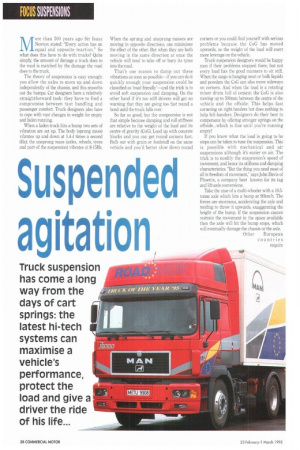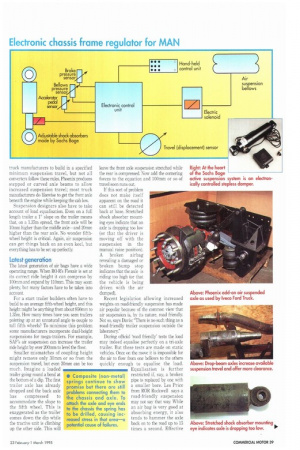Suspende agitation
Page 40

Page 41

Page 42

If you've noticed an error in this article please click here to report it so we can fix it.
More than 300 years ago Sir Isaac Newton stated: "Every action has an ..... equal and opposite reaction." So that does this have to do with trucks? Quite simply, the amount of damage a truck does to the road is matched by the damage the road does to the truck.
The theory of suspension is easy enough: you allow the axles to move up and down independently of the chassis, and this smooths out the bumps. Car designers have a relatively straightforward task: they have to find a compromise between taut handling and passenger comfort. Truck designers also have to cope with vast changes in weight for empty and laden running.
When a laden truck hits a bump two sets of vibration are set up. The body (sprung mass) vibrates up and down at 1.4-4 times a second (Hz); the unsprung mass (axles, wheels, tyres and part of the suspension) vibrates at 8-15Hz. When the sprung and unsprung masses are moving in opposite directions, one minimises the effect of the other. But when they are both moving in the same direction at once the vehicle will tend to take off or bury its tyres into the road.
That's one reason to damp out these vibrations as soon as possible—if you can do it quickly enough your suspension could be classified as 'road friendly'—and the trick is to avoid soft suspension and damping. On the other hand if it's too stiff drivers will get no warning that they are going too fast round a bend until the truck falls over.
So far so good, but the compromise is not that simple because damping and roll stiffness are relative to the weight of the load and its centre of gravity (CoG). Load up with concrete blocks and you can get round corners fast, Bulk out with grain or feedstuff on the same vehicle and you'd better slow down round corners or you could find yourself with serious problems because the CoG has moved upwards, so the weight of the load will exert more leverage on the vehicle.
Truck suspension designers would be happy men if their problems stopped there, but not every load has the good manners to sit still. When the cargo is hanging meat or bulk liquids and powders the CoG can also move sideways on corners. And when the load is a rotating mixer drum full of cement the CoG is also moving up to 500mm between the centre of the vehicle and the offside. This helps fast cornering on right-handers but does nothing to help left-handers. Designers do their best to compensate by offering stronger springs on the offside...which is fine until you're running empty!
If you know what the load is going to be steps can be taken to tune the suspension. This is possible with mechanical and air suspensions although it's easier on air. The trick is to modify the suspension's speed of movement, and hence its stiffness and damping characteristics. But the thing you need most of all is freedom of movement," says John Davis of Phoenix, a company best known for its tag and lift-axle conversions.
Take the case of a multi-wheeler with a 10.5tonne axle which hits a bump at 90km.th, The forces are enormous, accelerating the axle and tending to throw it upwards. exaggerating the height of the bump. If the suspension cannot restrain the movement in the space available then the axle will hit the bump stops, which will eventually damage the chassis or the axle. Other European countries require truck manufacturers to build in a specified minimum suspension travel, but not all converters follow these rules. Phoenix produces stepped or curved axle beams to allow increased suspension travel; most truck manufacturers do likewise to get the front axle beneath the engine while keeping the cab low.
Suspension designers also have to take account of load equalisation. Even on a full length trailer a 1° slope on the trailer means that, on a 1.35m spread, the front axle will be 10mm higher than the middle axle—and 20mm higher than the rear axle. No wonder fifthwheel height is critical. Again, air suspension can get things back on an even keel, but everything has to be set up perfectly.
Latest generation
The latest generation of air bags have a wide operating range. When RO-R's Flexair is set at its correct ride height it can compress by 100mm and expand by 110mm. This may seem plenty but many factors have to be taken into account.
For a start trailer builders often have to build to an average fifth-wheel height, and this height might he anything from about 950mm to 1.35m. How many times have you seen trailers pointing up at an unnatural angle to couple to tall fifth wheels? To minimise this problem some manufacturers incorporate dual-height suspensions for mega-trailers. For example, SAF's air suspension can increase the trailer ride height by over 200mm to level the floor.
Smaller mismatches of coupling height might remove only 30mm or so from the suspension travel, but even 30mm can be too much. Imagine a loaded trailer going round a bend at the bottom of a dip. The first trailer axle has already dropped and the back axle has compressed to accommodate the slope to the fifth wheel. This is exaggerated as the trailer comes down the dip while the tractive unit is climbing up the other side. This will leave the front axle suspension stretched while the rear is compressed. Now add the cornering forces to the equation and 100mm or so of travel soon runs out.
If this sort of problem does not make itself apparent on the road it can still be detected back at base. Stretched shock absorber mounting eyes indicate that an axle is dropping too low (or that the driver is moving off with the suspension in the manual raise position). A broken airbag revealing a damaged or broken bump stop indicates that the axle is riding too high (or that the vehicle is being driven with the air dumped).
Recent legislation allowing increased weights on road-friendly suspension has made air popular because of the common view that air suspension is, by its nature, road friendly. Not so, says Davis: "There is no such thing as a road-friendly trailer suspension outside the laboratory."
During official 'road friendly' tests the load may indeed equalise perfectly on a tri-axle trailer, Rut these tests are made on static vehicles. Once on the move it is impossible for the air to flow from one bellows to the others quickly enough to equalise the load. Equalisation is further restricted if, say, a broken pipe is replaced by one with a smaller bore. Les Price from ROR Rockwell says a road-friendly suspension may not say that way. While an air bag is very good at absorbing energy, it also tends to hammer the axle back on to the road up to 13 times a second. Effective
I dampers can prevent this, but there is often no outward sign that a damper is no longer working properly. A faulty internal valve can allow the fluid to pass almost unhindered, making axle damping almost non-existent. The latest load-dependent shock absorbers are fitted with three of four-position valves which offer different damping rates. The appropriate damper setting is selected, depending on the pressure in the air bellows. This setting will be retained until the load changes.
Semi active
MAN has gone one better on its latest F2000 range by fitting a semi-active suspension, using Sachs Boge shock absorbers controlled by Wabco electronics. Again, the starting point for determining roll stability is the pressure in the air suspension. But in addition the accelerator pedal position, brake system pressure and suspension-travel displacement are all monitored. The data is fed into the electronic control unit (ECU) which determines the optimum damper rate and sends the necessary instruction to the shock absorbers.
Inside the shock absorbers is a stepless valve arrangement which can alter the damping rate within five milliseconds.
The system automatically switches to a hard setting when cornering or on poor road surfaces. This makes the vehicle feel more sure-footed by reducing the roll angle and improving the ride on smaller roads. On a motorway the smooth surface and sweeping bends allow the system to select a softer setting. The electronics don't come cheap, but Sachs Boge says the stepless damper is actually cheaper to produce than the two or three-step units.
Scania is also looking at active damping and electronically controlled, two-part anti-roll bars which can have a torsional pre-load induced and adjusted during cornering, With ceaseless demands to reduce unladen weights, truck and suspension manufacturers can no longer simply over-engineer components to make them bomb proof. ROR Rockwell, for example, used to work to a safety factor of 2.3—all components were designed to handle 2.3 times the highest load they were expected to carry.
Now, like its competitors, ROR has adopted a fatigue and track testing procedure to simulate operating conditions. This means that components can be built with a much lower safety factor by using finite element analysis, and analysing the imposed stresses in the laboratory and on the test track conditions One such test involves spraying the component with a clear plastic which changes colour under polarised light according to the stress which is applied. This is used to identify areas of high stress: strain gauges are then fitted for further testing.
This all bodes well for the future of truck suspension but there is one problem: truck and trailer manufacturers are working on suspension designs independently. As Price says: "How can you design a combination if both parties don't speak?"
It means that a track's suspension may be set up for a trailer with a Cot; at 1.5m while the trailer manufacturer is busy producing a trailer with a CoG at 2,5m. With such a combination the trailer can tend to 'steer the tractive unit from the back, setting up strange handling problems.
As if there weren't enough variables, many chassis manufacturers plan to make greater use of air suspension for front axles and cabs, while Renault's VE20 concept vehicle looks to the future with its hydraulic suspension. This is not only compact; it lends itself to external control to serve as active suspension.
There is no doubt that in the future drivers and fragile loads alike will appreciate the benefits of 'intelligent' suspen-sion systems. As Sir Isaac
would be pleased to confirm, even with all these hi-tech advances, you still can't break the laws of physics—but around the world truck and suspension design teams are doing their best to bend them.
Ill by Colin Sovnnan














































































































